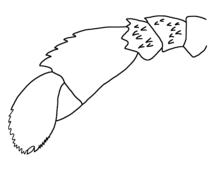| Eurypterina Temporal range: Middle Ordovician - Early Permian,
| |
|---|---|

| |
| The defining characteristic of eurypterine eurypterids is the transformation of the sixth pair of legs into swimming paddles. Reconstructed leg of Bassipterus. | |
| Scientific classification | |
| Domain: | Eukaryota |
| Kingdom: | Animalia |
| Phylum: | Arthropoda |
| Subphylum: | Chelicerata |
| Clade: | Sclerophorata |
| Order: | †Eurypterida |
| Suborder: | †Eurypterina Burmeister, 1843 |
| Type species | |
| †Eurypterus remipes De Kay, 1825
| |
| Subgroups | |
|
Incertae sedis | |
| Synonyms | |
| |
Eurypterina is one of two suborders of eurypterids, an extinct group of chelicerate arthropods commonly known as "sea scorpions". Eurypterine eurypterids are sometimes informally known as "swimming eurypterids".[1] They are known from fossil deposits worldwide, though primarily in North America and Europe.
Seventy-five percent of eurypterid species are eurypterines; this represents 99% of specimens.[2] The superfamily Pterygotioidea is the most species-rich clade, with 56 species, followed by the Adelophthalmoidea with 43 species; as sister taxa, they comprise the most derived eurypterines. Pterygotioidea includes the pterygotids, which are the only eurypterids known to have a cosmopolitan distribution.[3]
Though more numerous both in specimens and taxa, the eurypterines have the shorter temporal range of the two eurypterid suborders. They first appeared around the same time as the Stylonurina in the Middle Ordovician. The suborder faced a slow extinction during the Middle and Late Devonian, possibly tied to the emergence of jawed vertebrates.[4] Every Eurypterine genus and lineage went extinct before the Carboniferous save for Adelophthalmus which would go extinct in the Early Permian, millions of years before the Permian-Triassic extinction event that ended the stylonurines.[5]
- ^ Tetlie, O. Erik; Cuggy, Michael B. (2007). "Phylogeny of the basal swimming eurypterids (Chelicerata; Eurypterida; Eurypterina)". Journal of Systematic Palaeontology. 5 (3): 345–356. doi:10.1017/S1477201907002131. ISSN 1477-2019. S2CID 88413267.
- ^ Dunlop JA, Penney D, Tetlie OE, Anderson LI (2008). "How many species of fossil arachnids are there?". Journal of Arachnology. 36 (2): 267–272. doi:10.1636/CH07-89.1. ISSN 0161-8202. S2CID 42371883.
- ^ Tetlie OE (2007). "Distribution and dispersal history of Eurypterida (Chelicerata)" (PDF). Palaeogeography, Palaeoclimatology, Palaeoecology. 252 (3–4): 557–574. doi:10.1016/j.palaeo.2007.05.011. Archived from the original (PDF) on 2011-07-18.
- ^ Lamsdell, James C.; Braddy, Simon J. (2009). "Cope's rule and Romer's theory: patterns of diversity and gigantism in eurypterids and Palaeozoic vertebrates". Biology Letters. 6 (2): 265–269. doi:10.1098/rsbl.2009.0700. ISSN 1744-9561. PMC 2865068. PMID 19828493. Supplemental material.
- ^ Lamsdell JC, Braddy SJ, Tetlie OE (2010). "The systematics and phylogeny of the Stylonurina (Arthropoda: Chelicerata: Eurypterida)". Journal of Systematic Palaeontology. 8 (1): 49–61. doi:10.1080/14772011003603564. S2CID 85398946.